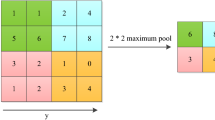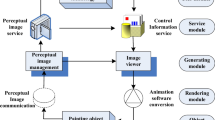Abstract
Oil painting education not only helps to improve students’ drawing skills and quality but also fosters creative thinking in the field of art. In order to keep up with the development of art diversity, it is essential to establish the concept of art diversity education and reform university oil painting education to meet the needs of modern society. This study aims to explore the potential value of image optical processing technology based on computer vision in the application of oil painting teaching image simulation. In order to improve students’ ability of oil painting simulation, this paper presents an image optical processing technology based on computer vision. The study collected a large number of oil painting images and teaching samples. Then, through image processing algorithm, we extract and analyze the optical features in the oil painting works, and then design an optical simulation method to apply these features to the students’ simulation works. By comparing the traditional methods and the techniques proposed in this paper, the image optical processing technology based on computer vision has potential practical value in the application of oil painting teaching image simulation, which can help students better understand and simulate the optical effects of traditional oil paintings.





Similar content being viewed by others
Data availability
The data will be available upon request.
References
Amani, M., Ghorbanian, A., Ahmadi, S.A., Kakooei, M., Moghimi, A., Mirmazloumi, S.M., Brisco, B.: Google earth engine cloud computing platform for remote sensing big data applications: a comprehensive review. IEEE J. Sel. Top. Appl. Earth Obs. Remote Sens. 13, 5326–5350 (2020)
Banka, R.: Contemporary Chinese art as a product and reflection of globalisation in culture. J East West Thought 7(3), 41–55 (2017)
Ersoz, Y., Şad, S.N.: Facebook as a peer-assessment platform: a case study in art teacher education context. Int. J. Assess. Tools Educ. 5(4), 740–753 (2018)
Gao, Y.: Ways to cultivate students’ innovative thinking in the teaching of oil painting in colleges. J. Contemp. Educ. Res. 5(10), 47–52 (2021)
Hird, J.N., DeLancey, E.R., McDermid, G.J., Kariyeva, J.: Google earth Engine, open-access satellite data, and machine learning in support of large-area probabilistic wetland mapping. Remote Sens. 9(12), 1315–1321 (2017)
Huang, Z.X., Jing, C.W.: Super-resolution reconstruction method of remote sensing image based on multi-feature fusion. IEEE Access 8, 18764–18771 (2020)
Jiang, H., Lu, C.: Information exchange platform for digital art teaching in colleges and universities based on internet of things technology. Int. J. Contin. Eng. Educ. Life Long Learn. 32(4), 459–473 (2022)
Jiang, Q., Liu, Z., Gu, K., Shao, F., Zhang, X., Liu, H., Lin, W.: Single image super-resolution quality assessment: a real-world dataset, subjective studies, and an objective metric. IEEE Trans. Image Process. 31, 2279–2294 (2022)
Li, H.: Design of multimedia teaching platform for Chinese folk art performance based on virtual reality technology. Int. J. Emerg. Technol. Learn. (online) 12(9), 28–35 (2017)
Li, H., Zheng, Q., Yan, W., Tao, R., Qi, X., Wen, Z.: Image super-resolution reconstruction for secure data transmission in Internet of Things environment. Math. Biosci. Eng. 18(5), 6652–6672 (2021)
Liu, Q., Chen, H., Crabbe, M.: Interactive study of multimedia and virtual technology in art education. Int. J. Emerg. Technol. Learn. (ijet) 16(1), 80–93 (2021)
Pan, B.: Digital image correlation for surface deformation measurement: historical developments, recent advances and future goals. Meas. Sci. Technol. 29(8), 082001–082008 (2018)
Wong, E., Dias, M.P.I., Ruan, L.: Predictive resource allocation for Tactile Internet capable passive optical LANs. J. Lightwave Technol. 35(13), 2629–2641 (2017)
Xu, X., He, Z.: Cultivation of students’ painting appreciation ability based on virtual reality. J. Sens. 2021, 1–14 (2021)
Yang, G.: The imagery and abstraction trend of Chinese contemporary oil painting. Linguist. Cult. Rev. 5(S2), 454–471 (2021)
Yue, L., Shen, H., Li, J., Yuan, Q., Zhang, H., Zhang, L.: Image super-resolution: the techniques, applications, and future. Signal Process. 128, 389–408 (2016)
Zhang, J., Shao, M., Yu, L., Li, Y.: Image super-resolution reconstruction based on sparse representation and deep learning. Signal Process.: Image Commun. 87, 115925–115932 (2020)
Funding
This paper was supported by (1) Research on the Forms and Development of Regional Art in the Guangxi Zhuang Autonomous Region(Project No:20FZX007); (2) 2022 Fifth Round of Guangxi Normal University Ideological and Political Model Curriculum Development Key Project “The Fundamentals of Oil Painting” (Project No.: 2022kcsz13).
Author information
Authors and Affiliations
Contributions
CF has done the first version, LZ has done the simulations. All authors have contributed to the paper’s analysis, discussion, writing, and revision.
Corresponding author
Ethics declarations
Conflict of interest
The authors declare that they have no competing interests.
Ethical approval
Not applicable.
Additional information
Publisher's Note
Springer Nature remains neutral with regard to jurisdictional claims in published maps and institutional affiliations.
Rights and permissions
Springer Nature or its licensor (e.g. a society or other partner) holds exclusive rights to this article under a publishing agreement with the author(s) or other rightsholder(s); author self-archiving of the accepted manuscript version of this article is solely governed by the terms of such publishing agreement and applicable law.
About this article
Cite this article
Fujun, C., Zhenliang, L. Application of image optical processing technology based on computer vision in image simulation of oil painting teaching. Opt Quant Electron 56, 511 (2024). https://doi.org/10.1007/s11082-023-06138-0
Received:
Accepted:
Published:
DOI: https://doi.org/10.1007/s11082-023-06138-0




